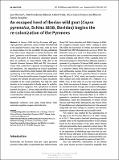Por favor, use este identificador para citar o enlazar a este item:
http://hdl.handle.net/10261/88228COMPARTIR / EXPORTAR:
 SHARE SHARE
 CORE
BASE CORE
BASE
|
|
| Visualizar otros formatos: MARC | Dublin Core | RDF | ORE | MODS | METS | DIDL | DATACITE | |

| Campo DC | Valor | Lengua/Idioma |
|---|---|---|
| dc.contributor.author | Herrero Cortés, Juan | - |
| dc.contributor.author | Fernández-Arberas, Olatz | - |
| dc.contributor.author | Prada, Carlos | - |
| dc.contributor.author | García Serrano, Alicia | - |
| dc.contributor.author | García-González, Ricardo | - |
| dc.date.accessioned | 2013-12-05T08:25:51Z | - |
| dc.date.available | 2013-12-05T08:25:51Z | - |
| dc.date.issued | 2013 | - |
| dc.identifier | doi: 10.1515/mammalia-2012-0014 | - |
| dc.identifier | issn: 0025-1461 | - |
| dc.identifier.citation | Mammalia 77(4): 403- 407 (2013) | - |
| dc.identifier.uri | http://hdl.handle.net/10261/88228 | - |
| dc.description.abstract | In January 2000, the last Pyrenean wild goat, Capra pyrenaica pyrenaica, died in Ordesa National Park in the Spanish Pyrenees. Since that time, there has been an intense debate over the possibility of using individuals from other extant subspecies to restore the Iberian wild goat C. pyrenaica in the Pyrenees. In the late 1990s, some Iberian wild goats of the hispanica subspecies escaped from an enclosure in Guara Nature Park, also in the Spanish Pyrenees. Between 2006 and 2012, four annual counts were conducted to quantify the demographics of the population. This expanding but isolated population numbered at least 86 free-living Iberian wild goats in 2012, reproducing in the wild with a positive increasing trend (λ = 1.067). Given the small number of original animals that escaped, new releases are necessary to insure the genetic variability of the small population, but only if a clear decision on its conservation is finally made. In addition, the population is sympatric with a population of several hundred feral goats, C. hircus, which should be monitored closely, in order to detect any problems with competence or hybridization, although the latter has not been demonstrated in the wild. | - |
| dc.description.sponsorship | This research was financed by the Government of Aragon, through the Ecological Monitoring Program of Guara Nature Park. For their dedication, we thank the park rangers, technicians, and other volunteers who contributed to the field work. | - |
| dc.language.iso | eng | - |
| dc.publisher | Walter de Gruyter | - |
| dc.rights | openAccess | - |
| dc.subject | reintroduction | - |
| dc.subject | rangers | - |
| dc.subject | mountain ungulate | - |
| dc.subject | Guara Nature Park | - |
| dc.subject | feral goats | - |
| dc.subject | enclosure | - |
| dc.title | An escaped herd of Iberian wild goat (Capra pyrenaica, Schinz 1838, Bovidae) begins the re-colonization of the Pyrenees | - |
| dc.type | artículo | - |
| dc.identifier.doi | 10.1515/mammalia-2012-0014 | - |
| dc.relation.publisherversion | http://dx.doi.org/10.1515/mammalia-2012-0014 | - |
| dc.embargo.terms | 2014-05-03 | - |
| dc.date.updated | 2013-12-05T08:25:51Z | - |
| dc.description.version | Peer Reviewed | - |
| dc.type.coar | http://purl.org/coar/resource_type/c_6501 | es_ES |
| item.fulltext | With Fulltext | - |
| item.languageiso639-1 | en | - |
| item.openairecristype | http://purl.org/coar/resource_type/c_18cf | - |
| item.openairetype | artículo | - |
| item.cerifentitytype | Publications | - |
| item.grantfulltext | open | - |
| Aparece en las colecciones: | (IPE) Artículos | |
Ficheros en este ítem:
| Fichero | Descripción | Tamaño | Formato | |
|---|---|---|---|---|
| Herrero_etal._mammalia-2012-0014.pdf | 408,82 kB | Adobe PDF |  Visualizar/Abrir |
CORE Recommender
SCOPUSTM
Citations
7
checked on 03-abr-2024
WEB OF SCIENCETM
Citations
7
checked on 28-feb-2024
Page view(s)
430
checked on 23-abr-2024
Download(s)
500
checked on 23-abr-2024
Google ScholarTM
Check
Altmetric
Altmetric
NOTA: Los ítems de Digital.CSIC están protegidos por copyright, con todos los derechos reservados, a menos que se indique lo contrario.
